Track and field is a sport in which athletes compete in running, walking, jumping, and throwing events. Track events consist of running and walking races of various distances. Field events are contests in jumping or throwing. Track and field meets can be held indoors or outdoors. Men and women compete separately in a meet. In countries other than the United States, track and field is often called the sport of athletics.
Track and field is one of the most popular sports in the world. More than 200 nations belong to World Athletics, the governing body of track and field. World Athletics, formerly known as the International Association of Athletics Federations (IAAF), recognizes world records in more than 130 men’s and women’s outdoor and indoor events. The organization accepts world records in metric distances only, except for the mile run.
The track and the field
The track.
Outdoor running tracks are oval in shape and usually are laid out in a stadium. World Athletics rules specify that an outdoor running track should measure no less than 400 meters around. Most modern outdoor tracks are exactly that length. (One meter equals about 31/4 feet.) Older tracks consist of dirt or cinders. Most new tracks are made of a waterproof synthetic material and can be used in rainy weather.

Indoor tracks have a wooden or synthetic surface, and they often have banked turns. According to World Athletics rules, the preferred measurement for an indoor track is 200 meters.
Outdoor tracks are divided into eight or nine lanes. Runners must stay in their lanes for all races up to 400 meters and until they pass the first curve of 800-meter races. World Athletics rules state that a lane should measure from 1.22 to 1.25 meters (48 to 49 inches) in width.
The field.
Most field events take place in an area enclosed by the track. But in some meets, one or more throwing events are held outside the stadium to protect other athletes and spectators who crowd the field area or to avoid damaging the artificial turf that covers many athletic fields. The field includes runways for the jumping events. It also has circular areas of material such as concrete or asphalt for most of the throwing events.
Track events
Track events include a variety of races. Short races, called sprints, stress maximum speed, while distance races require more endurance. In certain running races, such as the hurdles and steeplechase, runners must go over barriers. Other races, called relays, involve teams of runners.
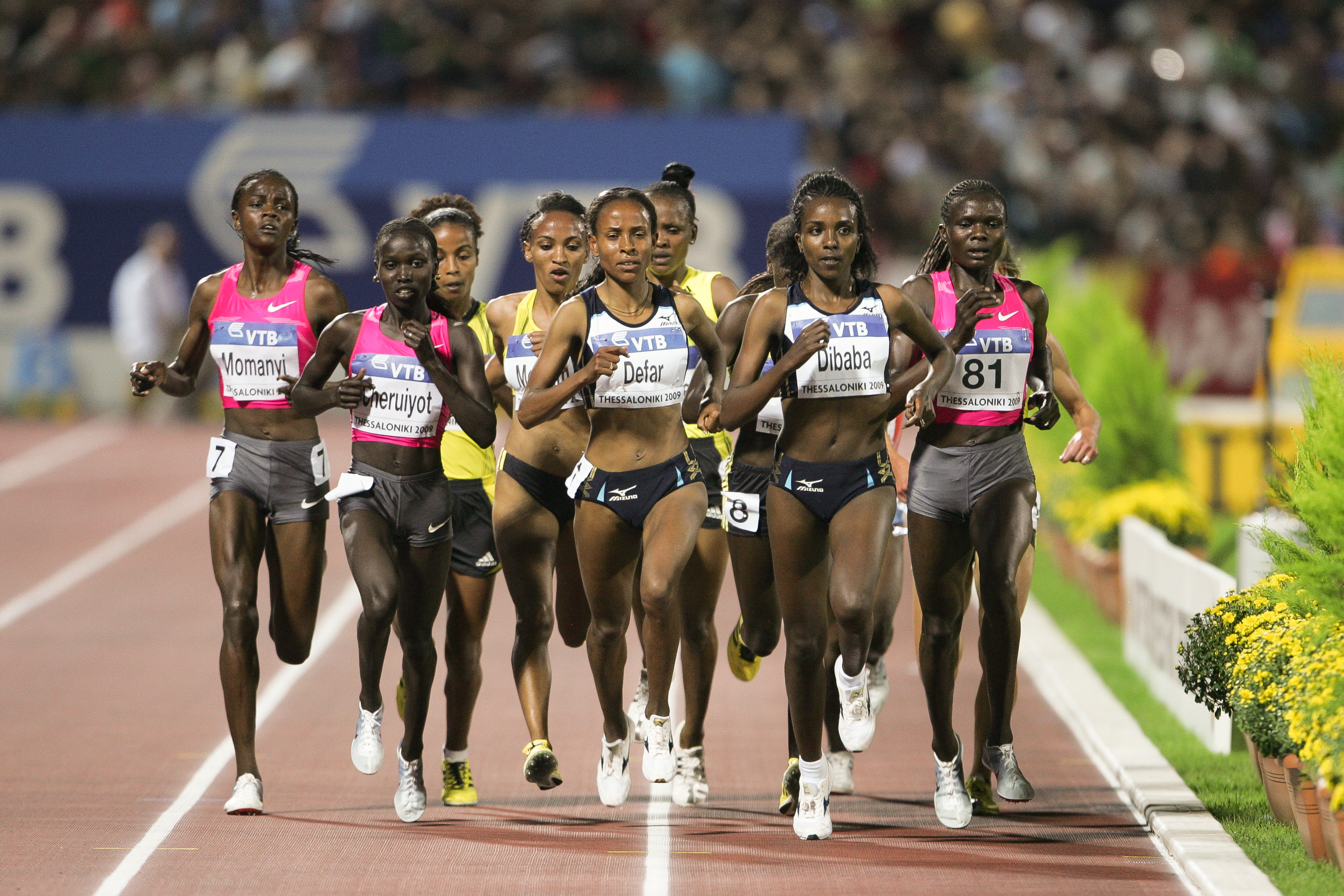
Running races
on an outdoor track cover distances from 100 meters to 10,000 meters. Indoors, races may measure from 50 meters to 5,000 meters. Cross-country races and road races are run outside the stadium. Cross-country competitors run over terrain such as hills and fields. Most U.S. and Canadian schools and colleges compete in cross-country races in the fall. Most road races are open to all runners, and many races award prize money to the winners. The most common distance for road races is 10 kilometers. See Cross-country; Running.
Hurdle races
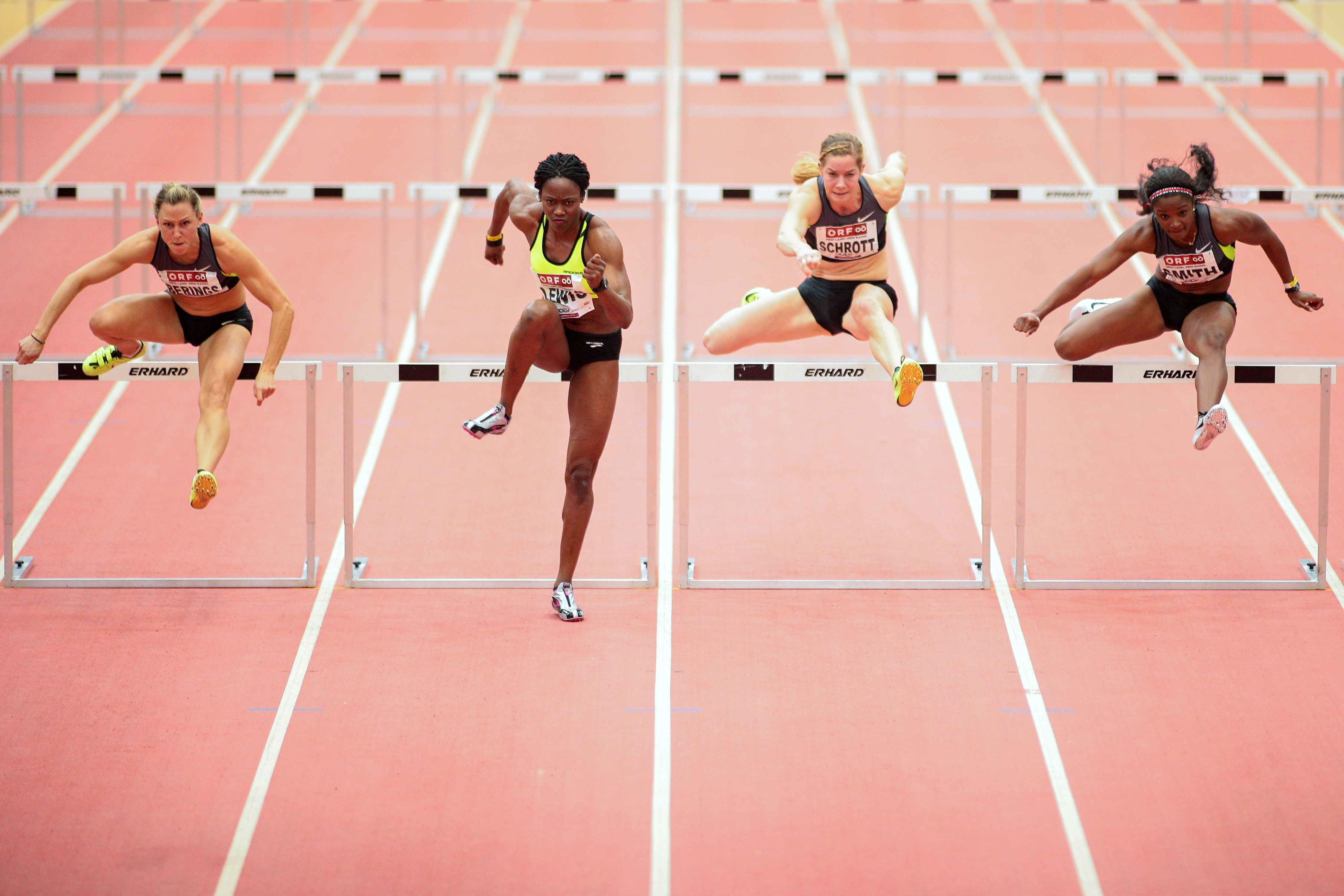
are events in which the competitors run over obstacles called hurdles. Most of these races have 10 hurdles spaced at equal intervals. There are two types of hurdle races, intermediate and high. Intermediate hurdles are 36 inches (91 centimeters) high for men and 30 inches (76 centimeters) high for women. Men’s high hurdles are 42 inches (107 centimeters) high. Women’s high hurdles are 33 inches (84 centimeters) high. Intermediate-hurdle races cover 400 meters or 440 yards in men’s and women’s competition. Most outdoor high-hurdle races are 110 meters or 120 yards for men and 100 meters for women. Runners can knock over hurdles without penalty, but contact with a hurdle normally slows down the runner. See Hurdling.
The steeplechase
is a race, usually of 3,000 meters, over two kinds of obstacles, hurdles and water jumps. Runners must clear intermediate-height hurdles 28 times. These hurdles are sturdier than the ones used in hurdle races, and runners may put a foot on top of them as they pass over them. Runners must cross water jumps seven times. A water jump consists of a hurdle and a water-filled pit 12 feet (3.66 meters) square. The steeplechaser steps onto the hurdle and leaps across the water. The pit is 271/2 inches (70 centimeters) deep at the foot of the hurdle and slopes up to the track level. Most steeplechasers come down in the water at the shallow end of the pit to soften their landing.
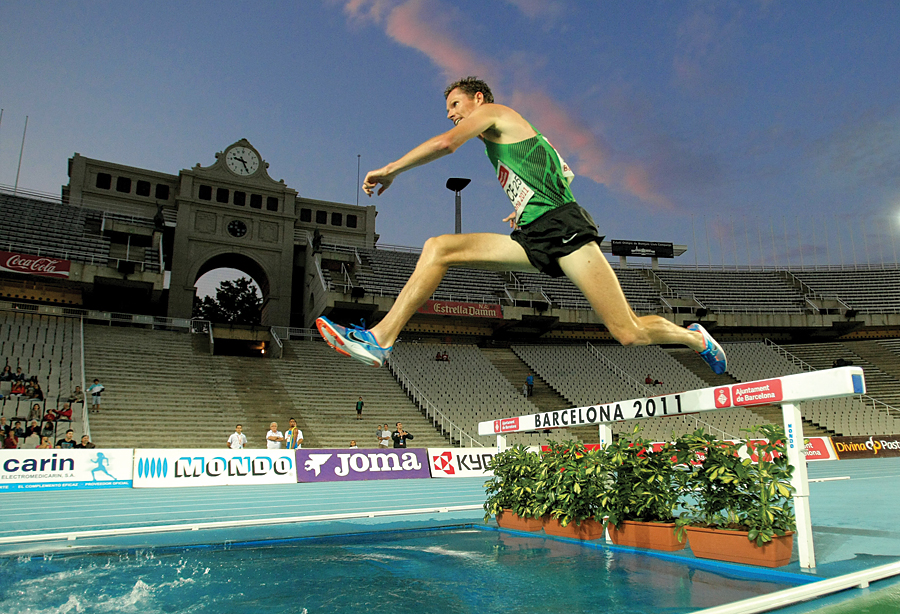
Walking races
are events in which athletes must follow certain rules of walking technique. The front foot must touch the ground before the rear foot leaves the ground. While the foot is touching the ground, the leg must be unbent for at least one moment. Walkers are disqualified after three judges observe the walker failing to use proper form. Walking races, also called race walking, may take place on a track or a road. In international competition, men’s walking races typically cover 20 kilometers or 50 kilometers, and women’s races typically cover 20 kilometers. See Walking.
Relays
are run by teams of four runners. The first runner carries a baton about 1 foot (30 centimeters) long. After running a certain distance, called a leg, the athlete hands the baton to the next team member. This exchange must occur within a zone 20 meters long. If the runners do not exchange the baton within this zone, their team is disqualified.
The most common relays are run at distances of 400 meters or 1,600 meters. World Athletics also keeps world records for relays of 800 meters, 3,200 meters, and 6,000 meters. In these relays, all four members of a team run an equal distance. Most U.S. relay meets include medley relays, in which the athletes run different distances. In the sprint medley, two members of the team run 200 meters each, another runs 400 meters, and the final runner covers 800 meters. In the distance medley, the members of the team run distances of 400 meters, 800 meters, 1,200 meters, and 1,600 meters.
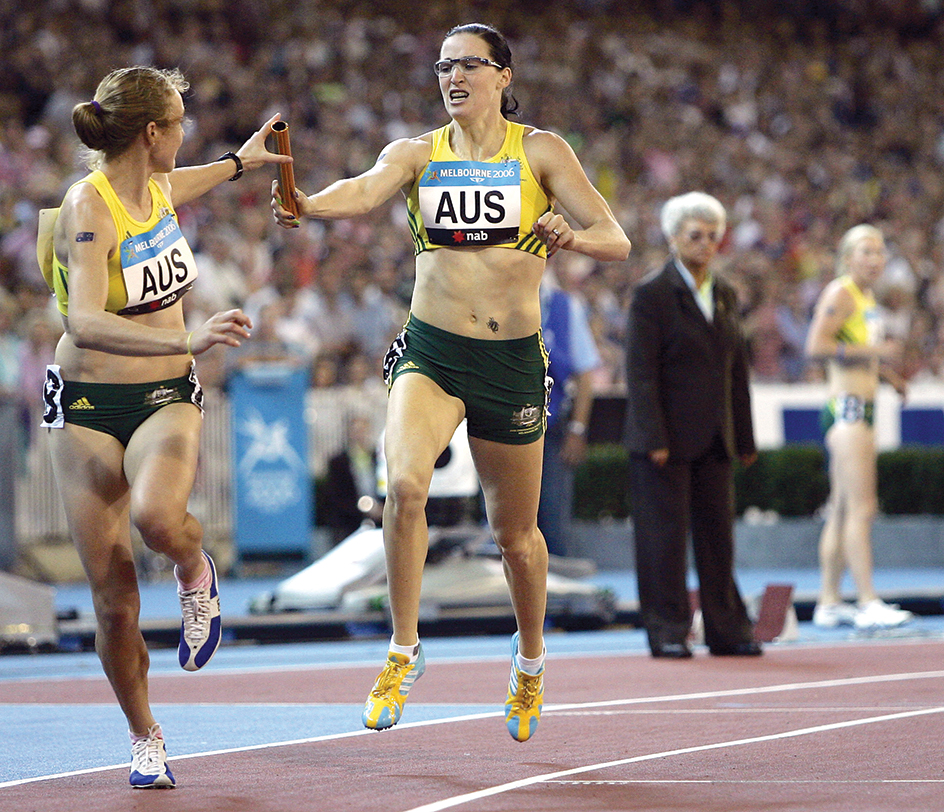
Field events
Field events take place in specially prepared areas, usually within the oval track. Typical field competition consists of four jumping events and four throwing events. The jumps are the long jump, triple jump, high jump, and pole vault. The throwing events are the discus, hammer, javelin, and shot-put.
Jumping events.
In the long jump and triple jump, the athletes jump as far forward as they can. In the high jump and pole vault, they leap over a bar as high as possible.
The long jump, once called the broad jump, is completed in a single jump into a pit filled with sand. To begin the long jump, the competitor sprints down a long runway and leaps from a take-off board. If the athlete steps past the board before jumping, the jump is a foul. A jump’s length is measured from the front edge of the take-off board to the nearest mark the athlete makes in the sand. When there are many competitors, each one is allowed three jumps. A certain number of leaders qualify for three more. When fewer athletes compete, each one is allowed six jumps. If two jumpers leap the same distance, the winner is the one with the next-best jump. See Long jump.
The triple jump, originally called the hop, step, and jump, consists of three continuous jumps. The first two are completed on the runway. On the first jump, the athlete takes off on one foot and lands on the same foot. On the second jump, the athlete lands on the other foot. At the end of the third jump, the athlete lands on both feet in a pit of sand. See Triple jump. 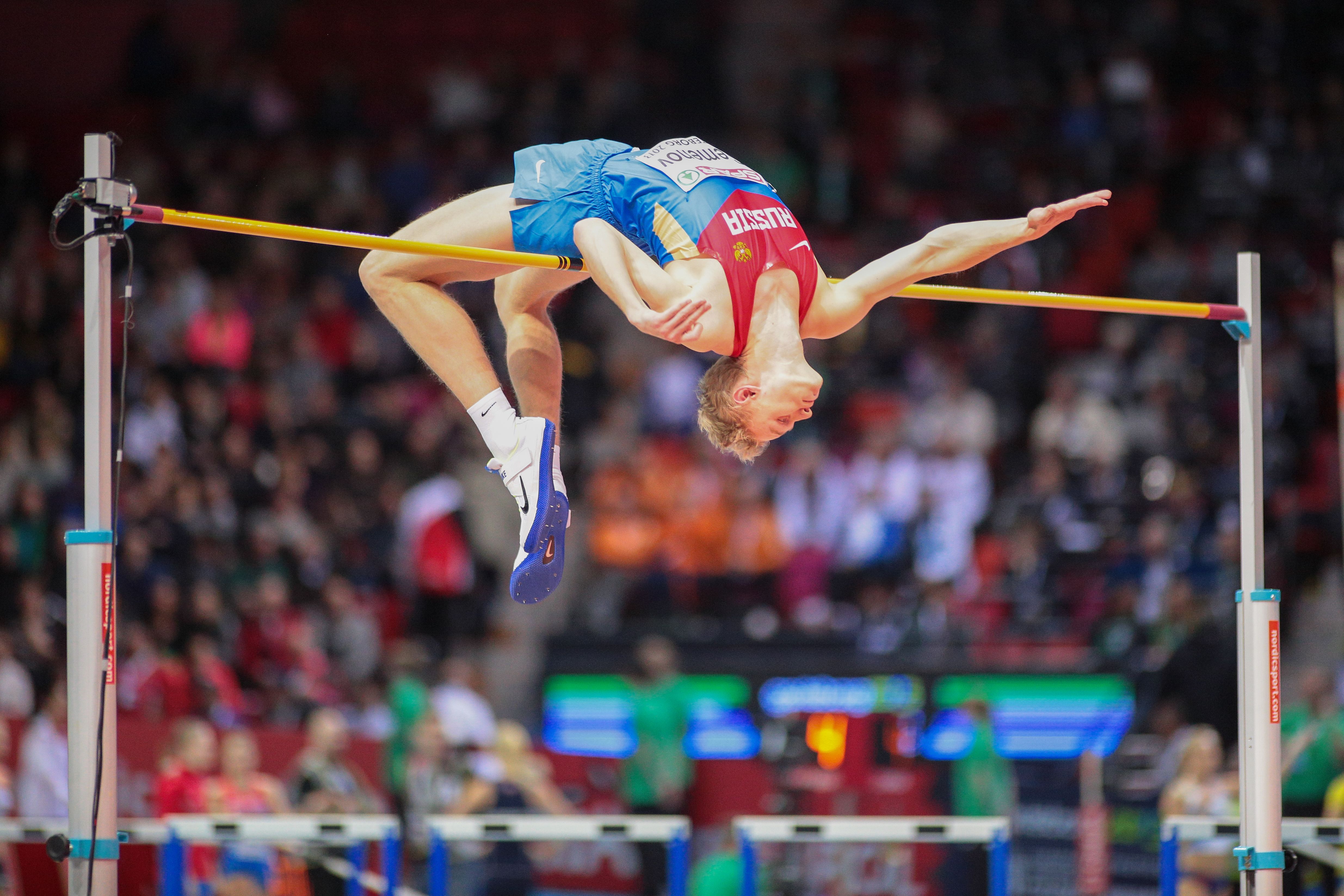
High-jumpers and pole-vaulters try to propel themselves over a long thin crossbar held up by two posts called uprights. The athletes land on a cushion of foam rubber. If a jumper knocks the crossbar off the uprights, the jump counts as a miss. Three consecutive misses eliminate the jumper. The winner is the one who clears the greatest height. In case of a tie, the winner is the one with the fewest misses at that height. If still tied, the winner is the one with the fewest overall misses.
A high jumper may run toward the bar from any angle. The athlete may use any style of jumping, but he or she must take off from one foot. In the most popular modern style, called the Fosbury flop, jumpers go over with their back to the bar and their head clearing first. The style was named for American high-jumper Dick Fosbury, who introduced it in the late 1960’s. See High jump.
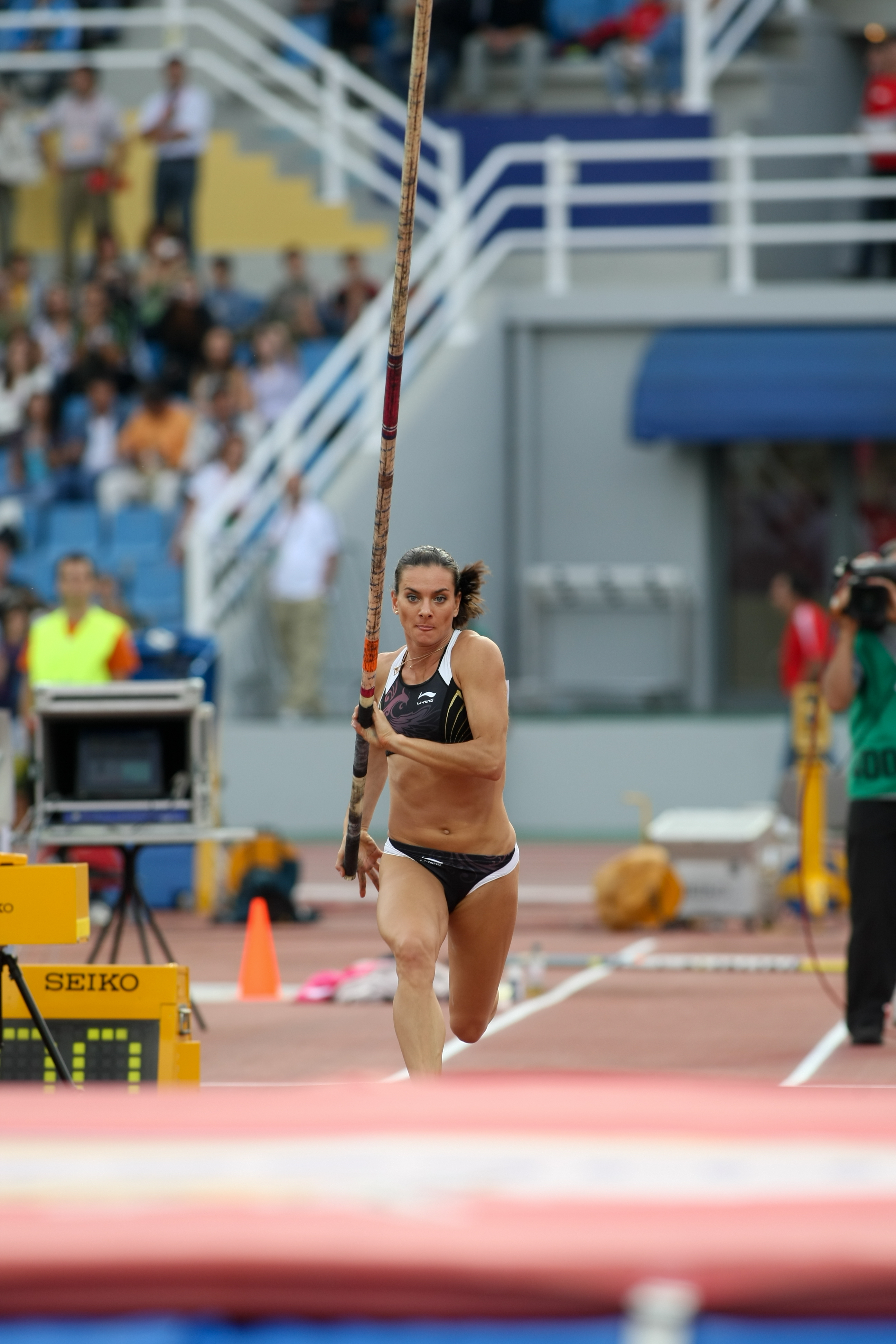
Pole vaulters use a long pole usually made of fiberglass. The vaulter begins the event by sprinting down a runway, carrying the pole with both hands. As the vaulter nears the vaulting pit, he or she rams the far end of the pole into a wood or metal box embedded in the ground. The pole bends while the athlete hangs with his or her back to the ground and feet up. As the pole straightens, helping to thrust the vaulter into the air, the athlete pulls himself or herself higher and turns his or her body to face the ground. Before releasing the pole, the vaulter gives a final push with the arms to add to his or her height. See Pole vault.
Throwing events
require athletes to propel an object as far as they can. Competitors in the discus, hammer, and shot-put all throw from inside a circle. In the discus and hammer events, athletes throw from an enclosure, called a cage, to protect spectators from wild throws. In the javelin event, the athlete runs down a runway and throws the javelin before reaching a foul line. In each event, the thrown object must land within a marked area. Ties are decided by the next-best throw.
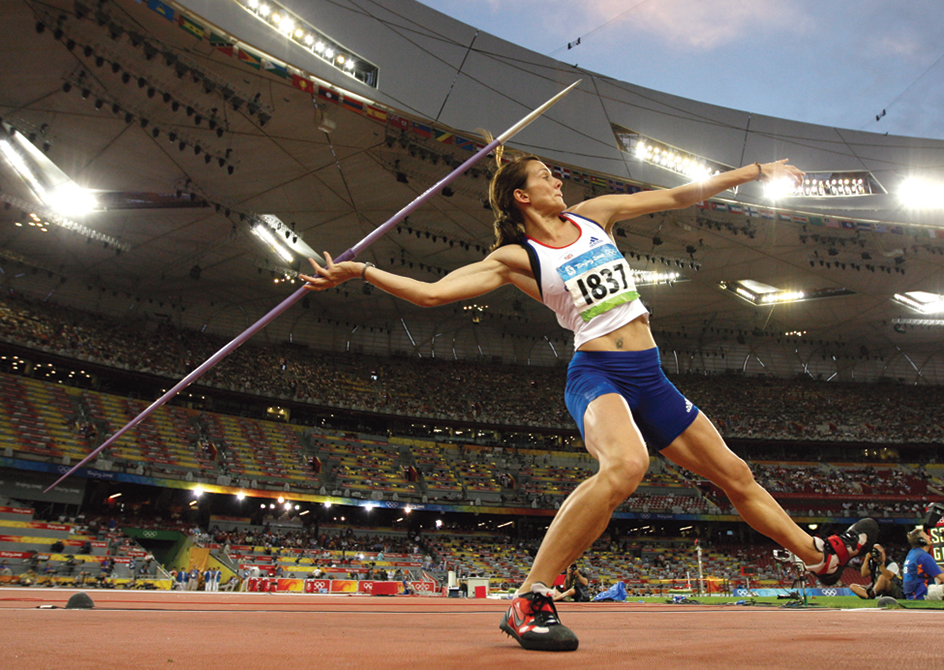
A discus is a saucer-shaped object made of plastic or wood with a metal rim. The men’s discus measures about 22 centimeters (82/3 inches) in diameter and weighs at least 2 kilograms (4 pounds 61/2 ounces). The women’s discus is about 18 centimeters (71/8 inches) in diameter and weighs at least 1 kilogram (2 pounds 3 ounces). The athlete grips the discus with one hand, spins around about 11/2 times, and releases it with a sidearm motion to make it sail through the air. See Discus throw.
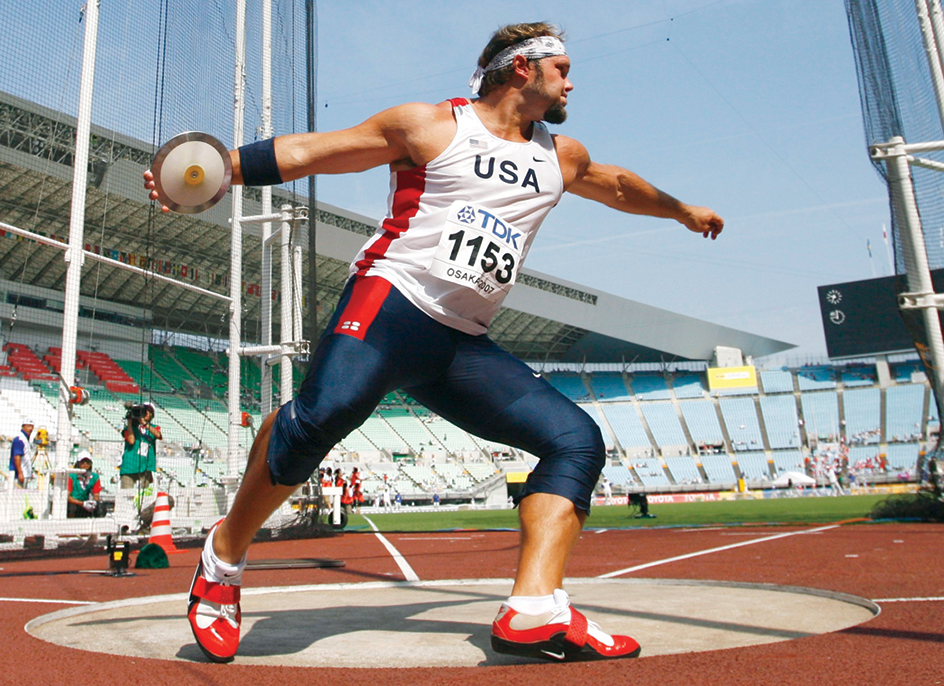
A hammer consists of a steel wire with a metal ball attached to one end. A handle is fastened to the other end. The men’s hammer weighs 7.26 kilograms (16 pounds) and measures about 120 centimeters (47 inches) long. The women’s hammer weighs 4 kilograms (8 pounds 13 ounces) and is slightly shorter in length. Using both hands, the thrower grasps the handle and spins around three or four times before releasing it. See Hammer throw.
A javelin is a spear made of metal or wood. The men’s javelin measures from 2.6 to 2.7 meters (8 feet 6 inches to 8 feet 10 inches) long and weighs at least 800 grams (28 ounces). Women throw a javelin that is 2.2 to 2.3 meters (7 feet 3 inches to 7 feet 7 inches) long and weighs at least 600 grams (21 ounces). The thrower holds the javelin by a cord grip near the center, and then releases it with an overhand throw while running. See Javelin.
A shot is a metal ball. The men’s shot measures about 12 centimeters (43/4 inches) in diameter and weighs at least 7.26 kilograms (16 pounds). The women’s shot measures about 10 centimeters (4 inches) in diameter and weighs at least 4 kilograms (8 pounds 13 ounces). Competitors put (push) the shot forward. They begin by holding the shot against the neck. There are two styles of shot put. In the slide, the athlete starts with a strong shove from one leg and finishes with a powerful push of the arm. In the rotation style, the athlete turns 11/2 times before releasing the shot in a movement similar to throwing the discus. See Shot-put.
The decathlon, heptathlon, and pentathlon
The decathlon, heptathlon, and pentathlon are combined competitions, in which an athlete competes in several different events over a period of one or two days. The athletes receive a score for their performance in each event, based on World Athletics scoring tables. The winner is the athlete who receives the highest total score. Thus, the champion is the best all-around athlete, not necessarily the best competitor in any single event.
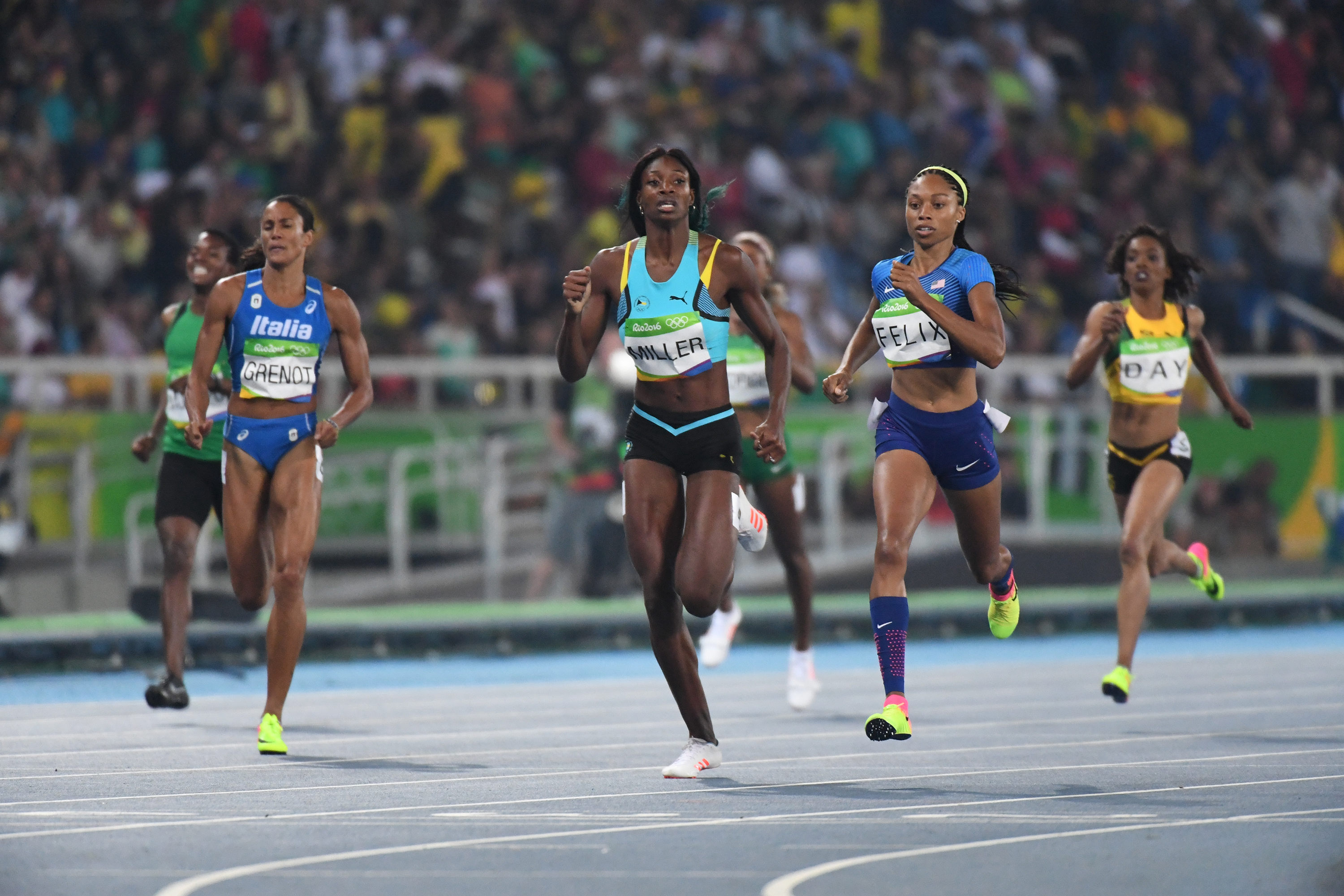
The decathlon is a 10-event competition for men. On the first day, the participants compete in the 100-meter run, long jump, shot-put, high jump, and 400-meter run. On the second day, they compete in the high hurdles, discus, pole vault, javelin, and 1,500-meter run. See Decathlon.
The heptathlon is a seven-event competition for women. If the competition is conducted over two days, on the first day athletes begin with the high hurdles, followed by the high jump, shot-put, and 200-meter run. On the second day, they compete in the long jump, javelin throw, and the 800-meter run. See Heptathlon.

The pentathlon, a one-day competition of five events, is held infrequently today. The heptathlon replaced the pentathlon for women in most outdoor events in 1981. Pentathlon events include the high hurdles, high jump, shot-put, long jump, and the 800-meter or 1,500-meter run. The pentathlon, sometimes called the athletics pentathlon, differs from the modern pentathlon, which features fencing, swimming, horseback riding, running, and target shooting. See Pentathlon, Modern.
Competition
Organizations.
World Athletics, formerly known as the IAAF, governs international track and field. It conducts the World Championships and cooperates with the International Olympic Committee in staging the track and field events of the Olympic Games. The World Athletics website at https://worldathletics.org/offers an up-to-date list of world records in the various track and field events. Other organizations conduct international meets, national championships, and restricted championships, such as college, regional, and high school meets.
In the United States, USA Track and Field (USATF) is the governing body for track and field. Athletics Canada governs the sport in Canada. The National Collegiate Athletic Association (NCAA) and the National Association of Intercollegiate Athletics (NAIA) govern U.S. college championships. The National Federation of State High School Associations regulates U.S. high school competition.
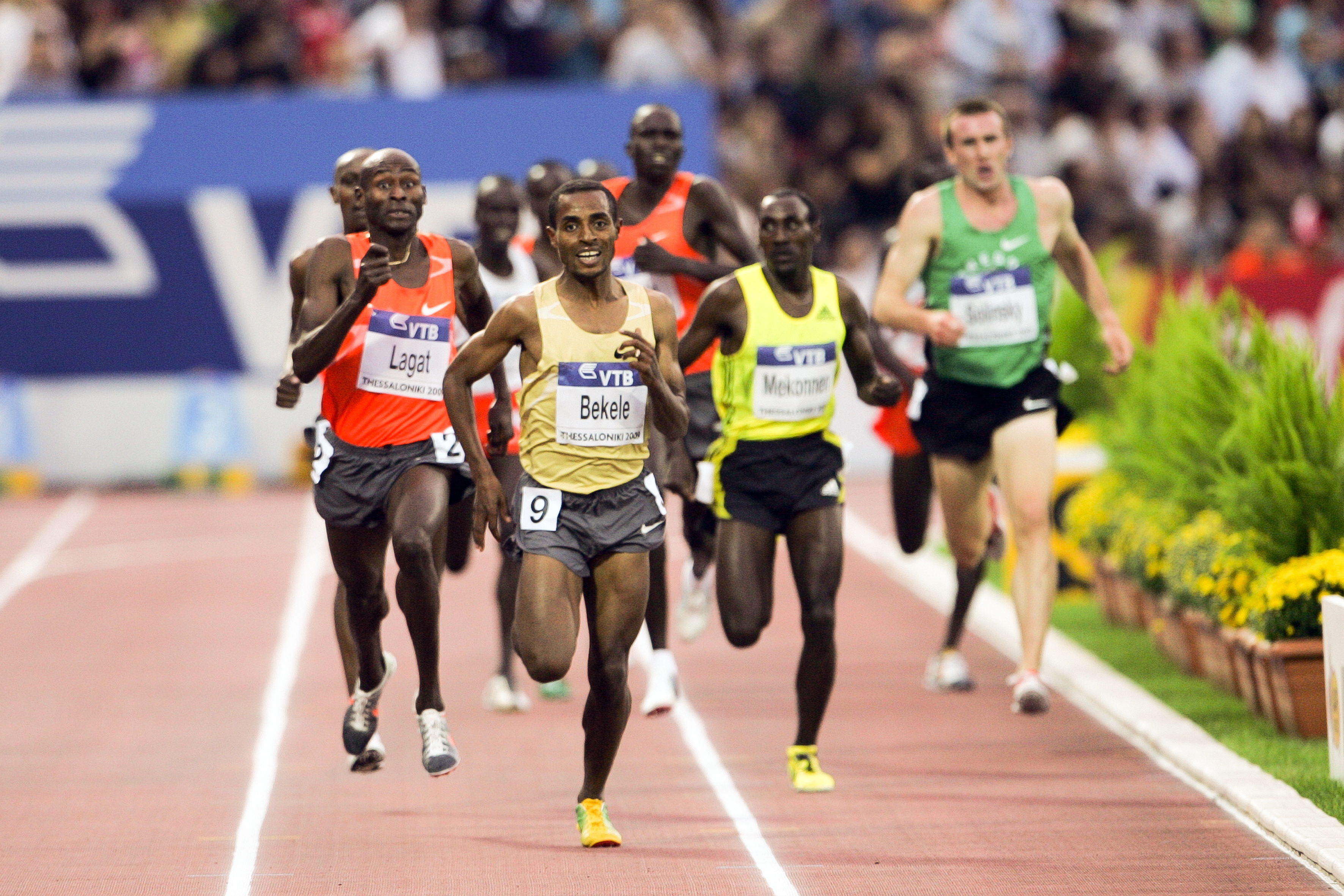
Types of competition.
The most important international meets are the Olympic Games, which started in 1896, and the World Championships, which began in 1983. The Olympics are held every four years, while the World Championships are held every two years.
Other major international meets include the African Championships, the Commonwealth Games, the European Championships, the Pan American Games, and the World Cup. Many nations compete against each other in annual dual meets (competitions between two teams).
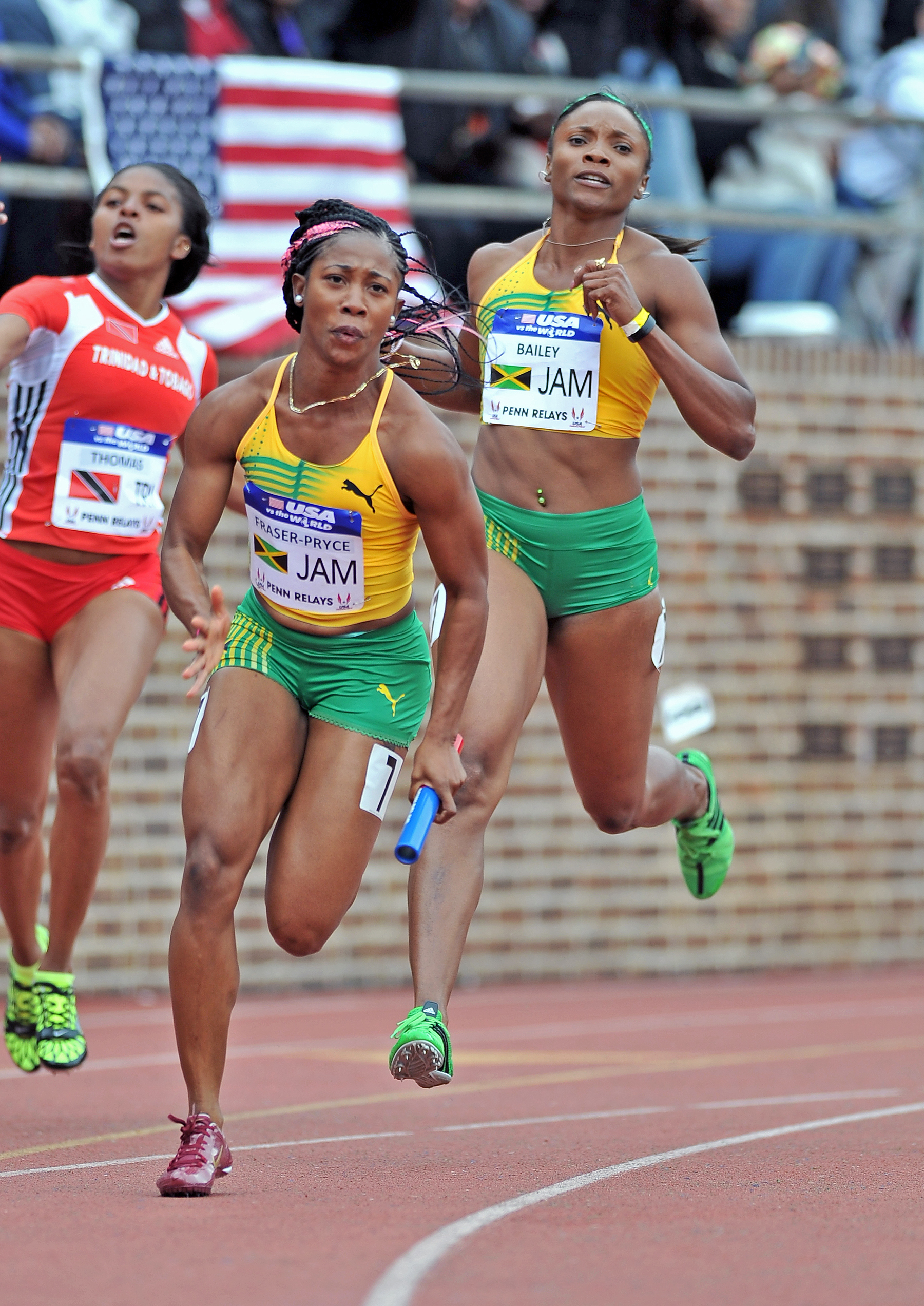
In United States and Canadian schools and colleges, local meets may lead to regional, state, or provincial meets and, on the college level, to national meets. Much competition takes place in open meets, which any athlete may enter. Some private organizations sponsor invitational meets. Only the athletes invited by the organizers may compete in these meets. International Grand Prix meets allow athletes to score points for placing high in certain meets. At the end of the season, the athletes with the most points win prize money. Some track and field meets are restricted to a certain age group, such as competitions for children 10 and under and adults 60 and over.
Track and field meets.
A typical track meet has several events taking place at the same time. Officials conduct each event according to its particular rules. A race requires a starter, several judges at the finish line, and sometimes as many as a dozen timers. Electronic equipment is normally used in place of some judges and timers in major meets. In field events, judges measure jumps and throws, and watch for fouls. In some events, judges also check to see that athletes are using the legal form.
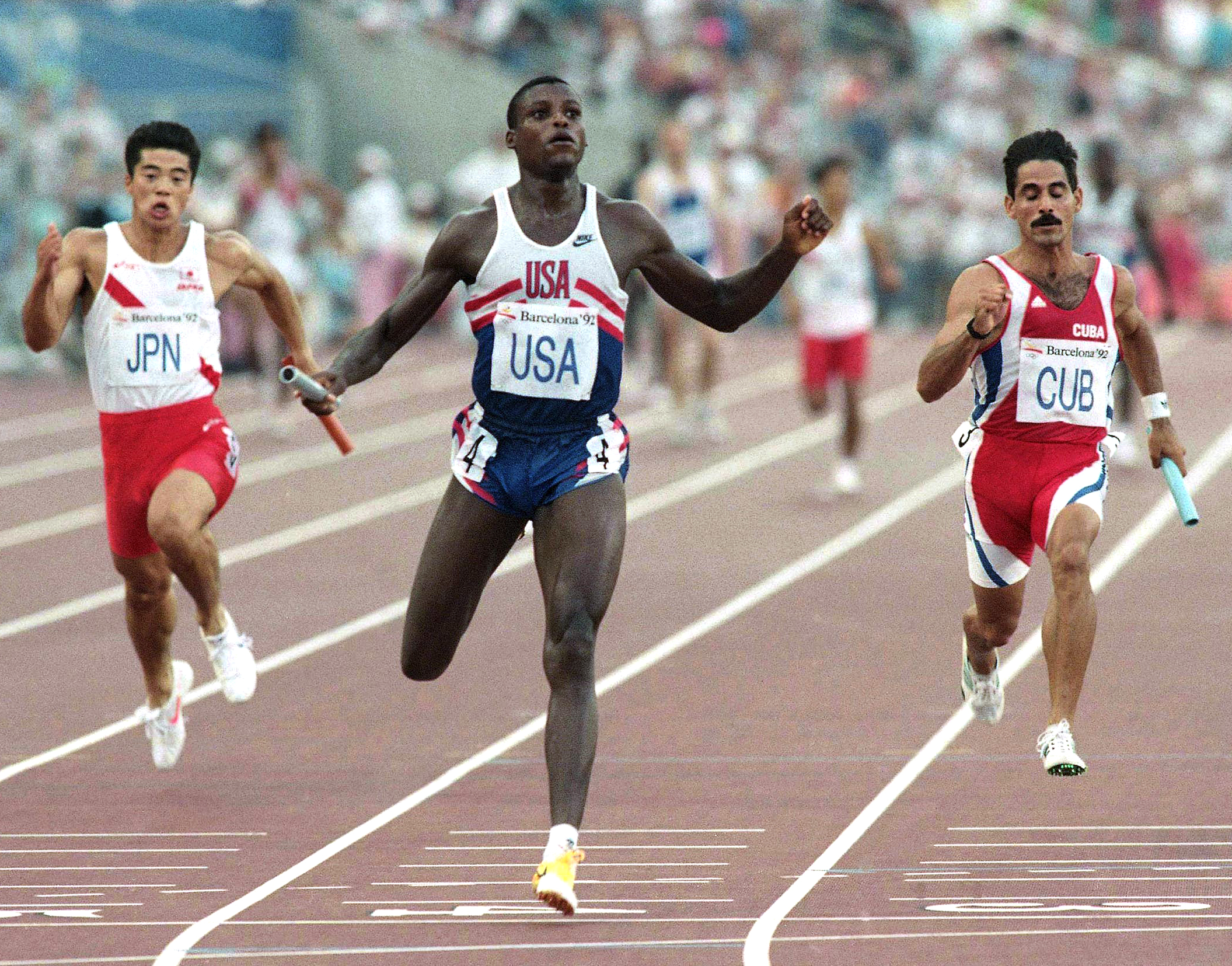
Most meets take place in a single day, but the Olympics and the World Championships schedule events over more than a week. Large meets include so many athletes that they cannot all compete at once. In these meets, the athletes must qualify for the finals in preliminaries. Eight competitors normally qualify for the finals of track events run in lanes. Most field-event preliminaries reduce the number of finalists to 12.
History
Beginnings.
The first footrace probably took place thousands of years ago. A footrace is described in the Greek epic poem the Iliad, which was probably composed in the 700’s B.C. A footrace was the only event in the first Olympic Games, held in Greece in 776 B.C. Track and field was introduced in England in the 1100’s but did not become popular until the 1800’s.
Revival in the 1800’s.
Footraces along the roads became common in England during the 1500’s, but races on measured tracks did not begin until well into the 1800’s. Modern track and field began in the schools of England. Eton held an interclass meet in 1837. In 1864, Cambridge competed against Oxford in the first intercollegiate track and field meet. The annual English championships began in London in 1866.
The first U.S. amateur meet took place indoors in 1868. The New York Athletic Club sponsored the meet. United States collegiate meets and the first national championships began in 1876. Several other nations held championship meets before 1900. In 1895, the New York Athletic Club met the London Athletic Club in the first notable international meet. In 1896, Athens, Greece, hosted the first modern Olympic Games. Although the track and field performances at Athens were not outstanding, the Olympics stimulated great interest in the sport. Women’s competitions, which were not part of the first Olympic Games, also began during the late 1800’s.
The early and mid-1900’s.
In 1912, 16 countries agreed to form the IAAF to govern men’s track and field. An international organization for women’s competitions was formed in 1917. Separate international women’s championships were held until 1928, when women were admitted to Olympic competition.
During the 1920’s, long-distance runner Paavo Nurmi of Finland raised track to international popularity. He broke 29 world records and won 9 Olympic gold medals and 3 silver medals. Babe Didrikson of the United States popularized women’s track and field. Didrikson won two gold medals and a silver medal in the 1932 Olympic Games. In the 1936 Olympics, Jesse Owens of the United States won four gold medals and retired with world records in seven Olympic events. Early in the 1940’s, Cornelius “Dutch” Warmerdam of the United States captured the imagination of the track and field world by pole-vaulting higher than 15 feet a total of 43 times.
Loading the player...Jesse Owens at the 1936 Summer Olympic Games
During the 1950’s, athletes broke all previous world records except Owens’s 1935 long-jump mark. Among the greatest athletes in this midcentury surge were long-distance runner Emil Zatopek of Czechoslovakia, and shot-putter Parry O’Brien and discus thrower Al Oerter of the United States. Zatopek won 4 Olympic gold medals in track and held 10 world records at the same time. O’Brien broke the shot-put record 13 times and won 2 firsts, a second, and a fourth in the Olympics. Oerter won the Olympic discus throw four times.
Track and field today.
The sport has changed greatly since the mid-1900’s. Performances once thought to be impossible are common today. In 1954, the British runner Roger Bannister became the first person to run the mile in less than four minutes. Within the next 20 years, more than 200 men had run the mile in under four minutes. By the early 1990’s, the 50 best performances in each event included only a few from before 1980.
There are a number of reasons for this remarkable progress in track and field. They include increased competition internationally, as well as improved training methods, equipment, and techniques. Traditionally, track and field has been an amateur sport. However, the rules have been broadened to allow athletes to receive large sums of money for endorsing athletic shoes or other products and for appearing in invitational meets, as well as prize money. The opportunity to earn money has increased the level of competition.
Improved training methods help today’s athletes perform well. Training with weights gives athletes greater strength for throwing, jumping, and even running. New equipment has raised performance levels. Synthetic tracks, which have more spring, cut a runner’s time by as much as one second per lap. The use of fiberglass vaulting poles instead of wooden ones has reduced Warmerdam’s once amazing heights to high-school performance levels. Newer techniques have also helped. In the high jump, for example, the use of the Fosbury flop added about 6 inches (15 centimeters) to most jumps.
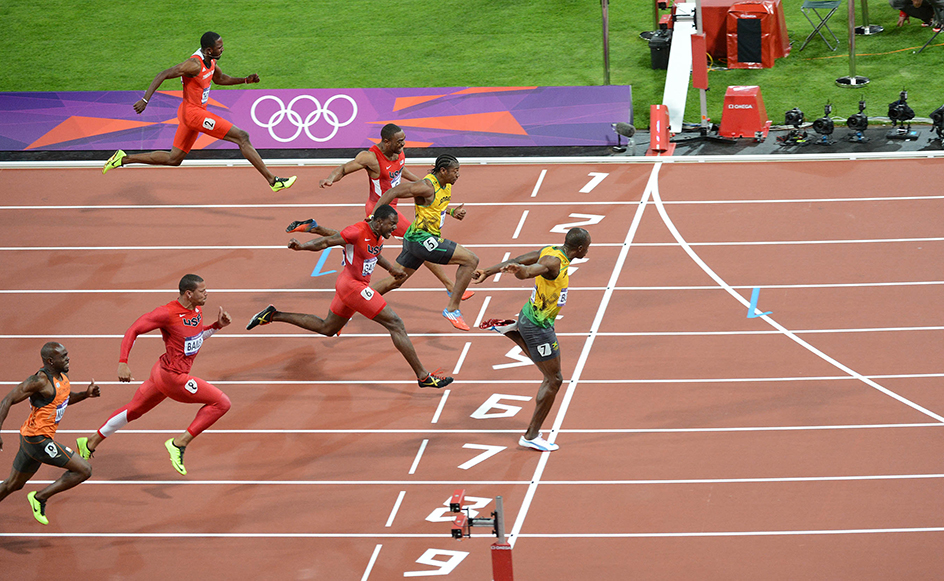
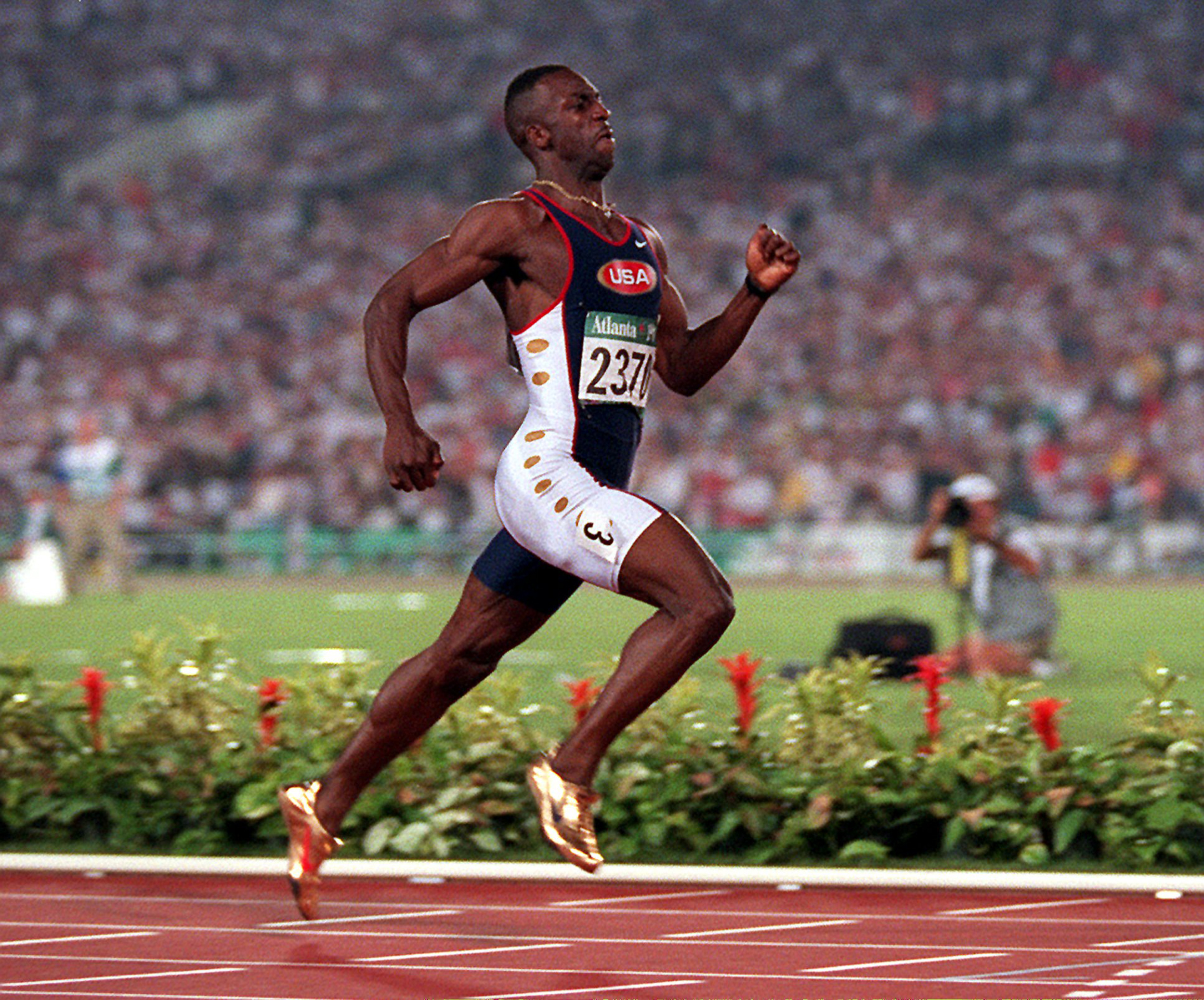
Modern track and field champions reflect the international popularity of the sport. The biggest names in modern men’s track and field have included sprinters Carl Lewis, Maurice Greene, and Michael Johnson, decathlon star Dan O’Brien, hurdler Edwin Moses, and long jumper Mike Powell of the United States; sprinters Usain Bolt of Jamaica and Donovan Bailey of Canada; hurdlers Colin Jackson of the United Kingdom and Karsten Warholm of Norway; pole vaulters Sergey Bubka of Ukraine and U.S.-born Armand “Mondo” Duplantis of Sweden; high jumper Javier Sotomayor of Cuba; middle-distance runners Sebastian Coe of the United Kingdom and David Rudisha of Kenya; and distance runners Said Aouita and Hicham El Guerrouj of Morocco, Haile Gebrselassie and Kenenisa Bekele of Ethiopia, Noureddine Morceli of Algeria, Jakob Ingebrigtsen of Norway, and Joshua Cheptegei of Uganda. 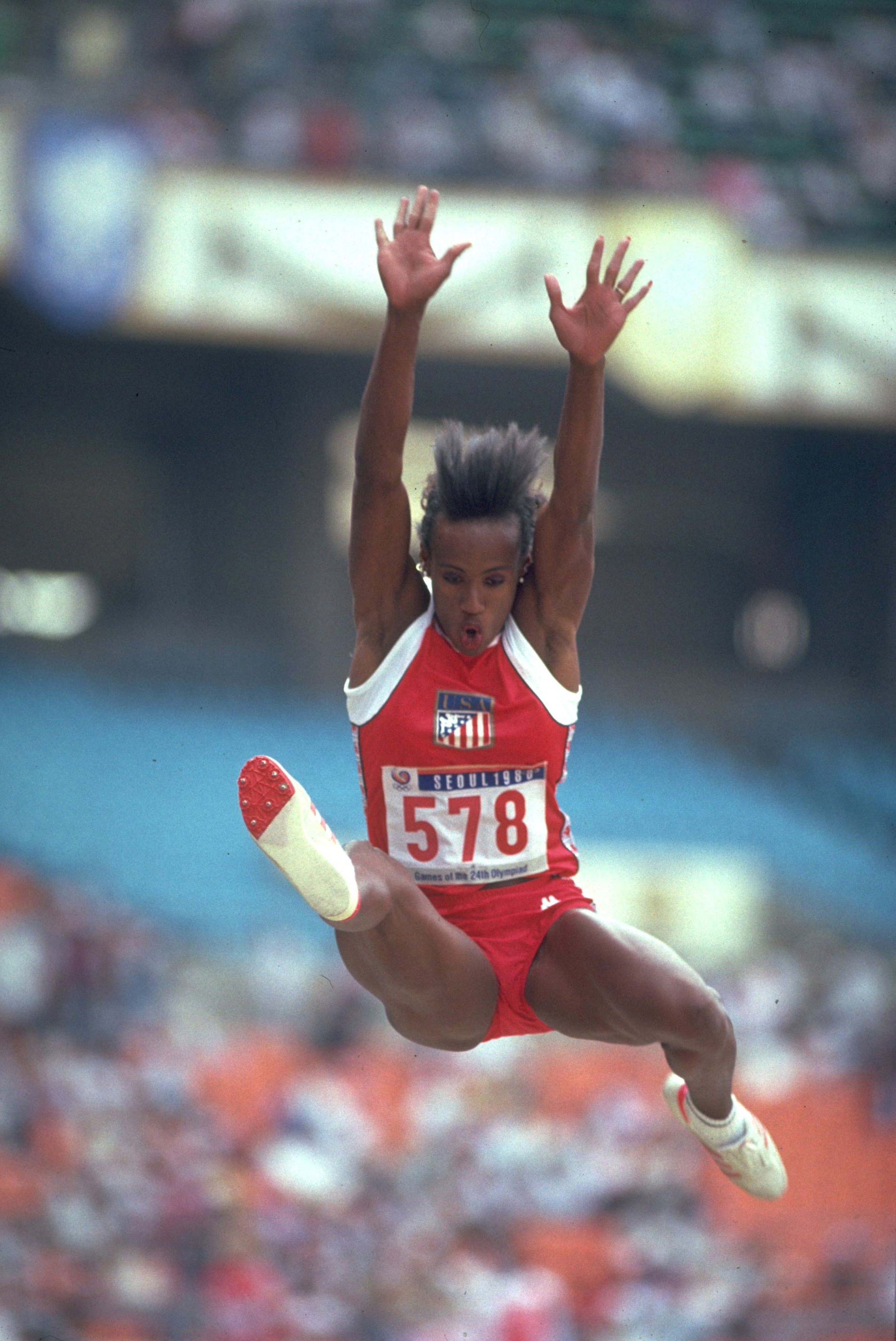
Star women athletes have included sprinters Gail Devers and Allyson Felix, heptathlon champion Jackie Joyner-Kersee, hurdler Sydney McLaughlin, and middle-distance runner Athing Mu of the United States; sprinters Merlene Ottey, Shelly-Ann Fraser-Pryce, and Elaine Thompson-Herah of Jamaica; long jumper Heike Drechsler of Germany; distance runners Vivian Cheruiyot of Kenya, Almaz Ayana and sisters Genzebe and Tirunesh Dibaba of Ethiopia, and Ethiopian-born Sifan Hassan of the Netherlands; middle-distance runners Keely Hodgkinson of the United Kingdom, Svetlana Masterkova of Russia, Maria Mutola of Mozambique, and Caster Semenya of South Africa; and pole vaulter Yelena Isinbayeva of Russia.
